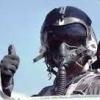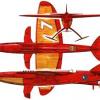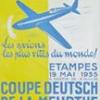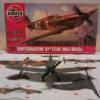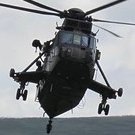Search the Community
Showing results for tags '1940'.
-
I wasn't at all sure which forum to post this little exercise in. It's military vehicles, but not; it's aircraft related, but not. So, rather than risk the ire of the moderators, I will post here. I like to create vignettes or small dioramas when taking nice photos of my model aircraft efforts. For years now, I've been trying to make sure any supporting vehicles are period correct - no easy task, especially when you leave the comfort of UK airfields in 1940. Anyway, one of those jobs I planned to get around to was sorting out some suitable bomb trolleys and their loads. Airfix was kind enough to produce a 1/72nd scale set of airfield accessories a few years ago. Vehicles, ladders, platforms, bombs and so on, it all came in handy. The bombs in the set were mostly for a bit later in the Second World War for me, but the trolleys were more or less correct. Only a pair of them, though. A bit limiting if you want to reproduce the classic bomb train images often seen on bomber airfields at the time. Back in 1966 Airfix had produced a kit for the Short Stirling, and that included a David Brown tractor and four bomb trolleys. Having one in the stash, I raided it for parts, and hoped I could use the bomb load as well. Here's a shot showing the four Stirling trolleys with one of the later Airfix ones at the front. The Stirling kit ones are basic, but of their time. They do represent something like the trolleys in service at the start of the war, and as such will do until something better comes along. The only enhancement I could reasonably do was to spin the rather conical-shaped wheels up in my Dremel and sand them down to a better tyre shape. Right, that's the carrying set-up organised. What about loads. How do the Stirling bombs stack up? Well, to be charitable, and considering they're from a mould nearly 60 years old, they're vaguely bomb-shaped. The bomb casings were split in two and needed gluing together, but that left a ridge that would need sanding down. The tail rings, though, were nasty. Shaped more like buckets, with thick sides. Could I spend hours refining these? I felt I could better. I piled into my brass tube stocks, and amazingly found a suitable diameter right away. The task then was to cut off 16 pieces more or less the right size, and fit them to the bomb cases. Some time later, and after having made a fair stab at making the bombs more or less the right shape, I was ready to assemble things. Even later, and I got to this stage. I hope @Selwyn approves! I also hope he will correct any major errors I've made. Now, this pile of 250lb GP bombs is far from perfect. The shapes are pretty much anywhere, and I failed to glue the rings on square in many cases. The colour, trying to get close to the "buff" specified, was mixed from Humbrol 93 and Humbrol 24. The eau de nil and red rings were painted with a very fine brush and steady hand while the bomb was clamped in a battery-powered Black & Decker spinning as slow as my trigger finger would let it. I'm still unsure about the red tail rings - which denoted delayed action fuzes, apparently - but felt they would add a little variety to the load. I am open to correction, but assumed such bombs would be spread around in a normal bomb load for some variety. Trolleys loaded, Small Bomb Containers ready, and just masking tape straps to fit to stop the bombs bouncing off the trolleys as they head out round the perimeter track to their intended aircraft. I feel I want to do better, so I may well swap out the Stirling bombs in time. I have several modern Airfix bomber kits which have ordnance in them which will make a better fist of the overall shape. I also know Flightpath have some trolley kits which include bombs, so I shall save my pennies to get those. If there's enough interest in my 1940 rabbit hole I may well keep this thread going as I add other bits and bobs to my set dressing collection. I am trying to get good information on French, Belgian and Dutch airfield support equipment, and adding some German military stuff for the Luftwaffe. Perhaps you, dear reader, might be able to point me in suitable directions there. Thanks for looking!
- 52 replies
-
- 24
-

-
- 1940
- 1940 Obsession
-
(and 1 more)
Tagged with:
-
I am having a bit of a break from building large ships, and have decided to do some pre,during and immediately post Battle of Britain RAF and FAA builds. I’ve completed a Hurricane, Defiant, and two Spits, all in 1/48, and have started in on the larger planes in service or coming into service during 39-40. I just plain like the early RAF camouflage schemes with all their variations, and the FAA equally, and its an interesting period historically, where the RAF was undergoing rapid development in its organisation, doctrine, tactics and equipment. I was in two minds about starting a WIP about this particular build, but I thought I would post some progress photos and also draw on the collective wisdom on the forum when it comes to RAF aircraft in 39-40. For the twins, I’ve started in with one of the first Beaufighters to see service, but haven’t yet decided on the precise airframe. There are only a few reasonably documented aircraft from this period, so the choices are few. Its likely to end up being the well-modelled R2069 from 25 Squadron, or possibly a slighter later aircraft from 252 Squadron. I am tending towards R2069 because that fits the period and the photos of the 252 Squadron aircraft may be from early 1941. Also, the excellent side view published in Wingleader ‘Bristol Beaufighter’, puts the serial number for R2069 and its presence in 25 Squadron beyond doubt as long as you only use the Squadron Codes and not an individual aircraft letter. I’ve used the old but still good Tamiya Mk VI kit as the starting point rather than the newer, but reputedly more tricky Revell 1F. The Tamiya is an easy build and, in any case, the Revell kit still needs a few changes to model one of the first production batch. Most importantly, the required ‘early’ style cockpit canopy is available as a vacform from Falcon, and is designed to fit the Tamiya kit. I hope I have picked up all of the external features needed for an early 1F. The list of changes, related to the Tamiya kit goes like this: - no dihedral tail, in this case the Red Roo resin replacement. - early cockpit canopy with additional framing and a different shape. This is a Falcon vacform, designed to fit the Tamiya kit. The early canopy is a little longer than the late style, has a curved edge to the lower front, and the nose needs to be trimmed then built up to the correct profile to meet the canopy base. The canopy itself fits very well, but needs some plastic strip shims ( about 15 thou) added to the rear and lower mating surfaces of the fuselage for a good firm fit and a larger gluing surface. - short square section air intakes above the engines. I cut these down from the long intakes supplied in the kit, and added the small auxiliary intakes to the rear, visible on early aircraft. According to the Wingleader book, these are something to do with the early heating system on Beaufighters. - clearance bumps removed from the engine cowling, and the extended glow preventer panel removed from the front of the collector ring, and fresh air intakes removed from the front of the exhausts. These are all more typical of later Mark I and Mark VI on aircraft. - short plain exhausts. - battle damage repair scabs removed from the wings. These are a peculiarity of the Tamiya kit due to their using an ex-Portuguese Mk X which had been used as a repair hack as the information source for the kit. - .303 gun ports and ejector openings plugged as the first batch of production machines were built without wing guns. I don’t know whether the access hatches remained and have left them in place for now. - early style tailwheel (supplied in the kit), early style main wheels (CMK make these). - oil coolers in the wing leading edges without louvres or control rod. I have looked at every photo I can find of the early Beaufighters and these don’t seem to be present. Later machines show them clearly, even in shadow, but early machines lack them. I modified a pair of Red Roo resin replacement oil coolers to this plain style. I am building the machine all buttoned up so I have left the interior largely alone, except for depicting the early drum feeds and spare drums ahead of the navigators position. You really can’t see them, but they are in place. I have the Beau basically ready for painting. If I model R2069 as photographed then I have to add a VHF aerial immediately below the cockpit, and probably remove the mast between the cockpit and observers dome. The Wingleader book suggests that these early machines only carried VHF sets, rather than the earlier TR-9 sets with associated masts and aerials. The odd thing is that the photos of these aircraft show that the attachment points for the TR-9 aerial were fitted to the fixed rudder and likely the fuselage. I am wondering whether the removal was only temporary, as other early machines (eg 252 Squadron) show both the mast and aerial in place, or if these photos were doctored by the censor for some reason to erase the aerial and mast. There also seems to be a short antenna or mast just in front of the pilots canopy. I won’t copy these photos out of respect for copyright, but other, more learned members may have seen the same photos. Any thoughts? What else have I missed? cheers Steve
- 33 replies
-
- 14
-

-
- beaufighter
- 1/48
-
(and 1 more)
Tagged with:
-
I have mentioned in previous threads that I have something of a 1940 obsession. It started out innocently enough, with a plan to build at least one example of the aircraft that took part in the Battle of Britain, the Battle itself being another obsession in its own right. With the models I build I wanted to try to tell a wider story than the typical "brave boys in their Spitfires against the mighty Luftwaffe" kind. I began to add aircraft of Bomber, Coastal, Army Co-Operation commands, Fleet Air Arm and sundry others to the UK side in an attempt to even up the odds. When you realise more Bomber Command crew members died during the Battle period than Fighter Command losses, you begin to realise there is an untold story behind the myths of the Battle of Britain. Inevitably, the Battle of Britain edges started to blur. Interest started to shift backwards from the official July to October Battle period. The numbers of aircraft also grew, and it eventually became a plan to build at least one example of every type of aircraft that flew in the Western European theatre during the whole of 1940, from all sides of the conflict: Norway campaign, Phoney War, Blitzkrieg (France, Belgium, Holland), Operation Dynamo, Battle of Britain, Night Blitz, the beginnings of the Battle of the Atlantic, and the new types just coming into service at the end of 1940. So far, numerous models have been built and kits are in the stash, and steadily being acquired, which cover the types flown by the UK, Germany, France, Belgium, Holland, Norway, and Italy. I know: I’m a little bit mad. This work in progress thread will be about the French planes of 1940. Rather than start threads for each type, I’m lumping them all together in one place, though I’m not going to build them all at once. I’ll try and do the same for the other air forces as I get round to them. The bulk of the British and German protagonists have been built already, with only the oddities and strays to round up. I expect I’ll run individual threads for those. This particular thread will also be a bit about my journey of discovery, as I learn about the Armée de l'Air, the various aircraft the force could muster, and something about the pilots who flew them to try and stem the German invasion in the spring of 1940. I suspect there are some excellent references out there from France, but the language barrier is raised. While expanding my reference library is always a welcome, if sometimes expensive, pastime, I’m trying to rely on the World Wide Web, supplemented with some printed material, in order to move a little beyond what I find in the boxes. I suspect these builds, however, will mostly be straight "out of the box" builds. Honestly, most of the kits I’ve so far acquired seem sufficiently accurate to be able to do just that. I hope fellow BMers with be forthcoming to fill in the gaps in my knowledge, as I know there’s more than a few also interested in the events of 1940. So, what’s first on the agenda?
- 394 replies
-
- 17
-

-
- French Air Force
- 1940
-
(and 1 more)
Tagged with:
-
I’m feeling a bit of group build burnout, so I’ve decided to start a couple of builds of kits that have been occupying the stash for some time. Both, obviously, fit my 1940 remit, and both will probably be a fairly slow burn. First up, a final Fleet Air Arm build - until I can get a Fairey Sea Fox, Gloster Sea Gladiator and possibly a floatplane Swordfish - is the Blackburn Skua MkII from Special Hobby. Ages ago, I built the Roc turret fighter from SH, and this kit shares many similarities. This boxing dates from 2009, and offers three aircraft that took part in the attack on the Scharnhorst in July 1940. I may dig around and see if there are other aircraft I might choose, but one of the three in the box will probably be quite adequate. Typical SH family instructions. I’ve already made notes on colour callouts, and I will go over the runner trees with a fine felt tip to number the parts. Three runners of pale grey plastic form most of the parts. Some fine flash is evident, and some care tidying up feed points will be needed. The clear parts are a single piece canopy, so no chance of having the clamshell open for the observer, plus two landing light covers. A small PE fret for cockpit fittings, belts and engine detail. The engine is resin, and every inlet and exhaust pipe is separate. Transfers by AviPrint. I may be tempted to try cutting my own stencils and painting the markings, now I have the Silhouette. So, that’s what’s in the box. I’m not sure quite when I shall make a start on construction, but it won’t be too long. While my day job work is still busy, I am getting styrene and plastic cement fumes withdrawal symptoms!
- 121 replies
-
- 21
-

-
Those early naval aviators had big brass ones! Hoping you haven't seen this footage before. Film via YouTube. Looks like the F4U wasn't the only airplane that had a problem with bouncing over arresting cables. Mike
-
This build has taken me ages. I started it way back at the beginning of March, and thought it would be a quick build, but somehow I struggled with life impacting on both my time and my mojo, not to mention building several other kits alongside this one. The four GB's I joined this year have run one after the other, and maybe in retrospect I shouldn't have dived in quite so deep. However, the Defiant is now done, so I'm pleased with that. The kit was pretty good, only requiring a few minor fettles along the way, and I think it builds well and nails the essence of the Defiant really nicely. The kit was built largely OOB, with added Eduard PE. I managed to trash one of the decals so had to use some Xtradecals markings to salvage things. The paints were my usual Colourcoats enamels (courtesy of @Jamie @ Sovereign Hobbies) and spraying was done with a set of Topnotch camouflage masks. I used Mig Ammo panel line wash and pigments for weathering. WIP thread is here: Anyway, some images: So, there she is; not perfect but hey... I've still got a real soft spot for the Defiant and genuinely feel that her reputation is undeserved. Her crews were brave beyond brave and flew with an unsurpassed dedication to their duty, and for that they have my undying gratitude and respect. The Defiant was intended to attack a stream of unescorted bombers and when that didn't materialise, they were thrown into the fight to intercept the might of the Luftwaffe formations of both bombers and fighters. They shot down a surprisingly high number of German aircraft before being withdrawn from the front line following the decimation of 141 Squadron's Defiants in a battle known as the Slaughter Of The Innocents. Robert Verkaik's excellent book Defiant: The Untold Story of the Battle of Britain tells the story of the Defiant and the role it played in the strategic and tactical thinking behind the defence of Britain in the early part of the war, as well as the failures in the Chamberlain government's top brass's approach to air defence. The aircraft represented here, L7021, was flown by Squadron Leader G D Garvin and his gunner, Flight Lieutenant R C V Ash on the 28th of August 1940. The aircraft was badly damaged in combat with a Bf109 of JG26 (I haven't been able to identify who the pilot was) and the crew baled out of the burning fighter. S/L Garvin sustained minor injuries but F/L Ash was killed. L7201 impacted the ground near Faversham (see http://www.bbm.org.uk/airmen/Garvin.htm http://www.bbm.org.uk/airmen/Ash.htm and https://www.key.aero/forum/historic-aviation/31796-defiant-walkaround). Staggeringly, with hindsight, F/L Ash had requested a transfer to Defiants. His body was found riddled with machine gun bullets, suggesting that he may well have been attacked whilst making his descent by parachute. An imperfect aircraft used in imperfect circumstances, then, but a brave and steadfast crew, one of whom gave his life in the worst of circumstances during the defining air battle of WWII. Lest we forget... Thanks, JRK
- 9 replies
-
- 39
-

-

-
- 1940
- 264 squadron
-
(and 1 more)
Tagged with:
-
Fairey Swordfish MkI, K8393/E5A flown by Captain Oliver Patch RM and Lieutenant David G Goodwin RN, No 824 Naval Air Squadron, Fleet Air Arm, HMS Eagle. No 824 Squadron was originally part of HMS Eagle's air group in the Mediterranean, and was transferred to HMS Illustrious just before taking part in Operation Judgement, the attack against the Italian fleet at Taranto, Italy, 11/12 November 1940. Operation Judgement was itself part of a larger series of operations under the codename Operation MB8. It's a complex story, best read on the Wikipedia page. The Swordfish, nicknamed the Stringbag for its ability to carry almost anything rather like the 1940s housewives' string bag, really needs no introduction. If you are unfamiliar with the aircraft, perhaps a start with the Wikipedia entry would be a good primer for you. The new tool (albeit nearly a decade old now!) Airfix kit needs some effort, but makes up into a tidy scale representation of the classic biplane. I was lucky to acquire this particular boxing containing the Taranto raid markings as a secondhand purchase from a fellow Britmodeller. I added a photo etched rigging set from SBS Models, but otherwise the kit is built out of the box. I had been anticipating this build for some time, being a bit worried at the parts count and, well, it's a biplane. I felt it would make a good entry into the High Wing Group Build, and so the die was cast. I needn't have worried, as the kit was well thought through, and built up with very little trouble if you take your time over it. If you want to see the WIP thread, the link is below. As well as the aftermarket rigging set, I used the kit transfers, ColourCoats enamels for the main camouflage, and Humbrol acrylics and enamels for the detail painting. I have one or two more models to build to complete this part of my Fleet Air Arm 1940 collection, though I have yet to acquire a Sea Gladiator.
- 17 replies
-
- 56
-

-
Did the Defiant have the black wing and/or Sky fuselage band in May 1940? It seems not. Despite RAF fighters needing the bottom half black plus the Sky Type S fuselage band, and despite several colour profiles that show them with either, I haven't found a single photo, not from 1939, not from 1940. I did find photos of crashed Defiants that can definitively be placed in May 1940, and these don't show a fuselage band and don't show a black underside of the fuselage, but no details of the underside of the wing is visible. Should we agree that in May 1940 the Defiant used neither fuselage band nor black undersides? Or does someone here perhaps have that rare photo we've all been looking for, showing both? The next question would be: why didn't the Defiant carry the regulation scheme? Cheers.
- 53 replies
-
Hi, Next machine of Finnish air forces - the Gloster Gamecock II, build under licence in Finland. Some 20 machines were build, they have a bit extended fuselage like in Gamecock III, instead of typical short fulselage of original Gloster production. At the outbreak of WWII, which in case of Finland started with war against Soviet Union agression in 1939 some of them were still in use. That war was lasting till spring 1940 and Finns protected themselves however losing some the most east part of territory (which remains in Russian's hands till now). The Gamecock was obviously and definitly an obsolate machine at 1939, it was used in role of avanced trainer. Last machines were phased out in 1944 (!) - as far as I've read about it. There was a spectacular victory during Winter War achieved on Gamecock. On 29 January 1940 Soviet bomber DB 3 was captured by a single Gamecock. More about this event here: The GA-58 is one of three possible Gamecock codes of the capturing machine. The model is Broplan's first (?) and only (?) injection model . This is a typical short run to which I added some details as scratch build (in net there are available photos of sprues here: http://karopka.ru/community/user/17547/?MODEL=381419 ) Decals come from drawer (likely by AZ and letteing by Techmod), one small swastika on prop is hand paint, second is from SH Myrsky spare one. Here she is: Many thanks for Finnish collegues here on BM, Antii and Vessa as well the Mykko Kylemala of Finnish Museum of Aviation who helped me in gathering materials related to this build. Comments welcome Regards Jerzy-Wojtek
-
Hi, I am working now on Fokker biplanes and coming close to end I became doubtful about colours. The AZ CX says that should be brown/silver and LF CV reccoemnd green/blue - but I think that should both have similar scheme. There is a musem Dutch CVD Which has strong (intense) light blue bottom and brownish green top, but this green is dark as Humbrol 75... Is it a right interpretation? The IPMS Stockholm name it khaki and recommends xtracolours 251 which is not dark http://www.ipmsstockholm.org/magazine/2005/06/stuff_eng_dutch_af_colours_01.htm Any comments on this will be apprecieted Regards J-W
-
This is the old Testors Westland Lysander Mk.II from the Italeri reboxing, which I picked up second hand some years back. It includes the addition of the Eduard photo-etch interior and a some scratch building for adding some detail missing from the relatively basic kit. It was a build to fill a gap in my collection and was built around July to September last year (well before Hendie went on his epic and magnificent build of the same kit), Decals are based off the Xtradecal sheet for the centenary of No.II(AC) Squadron which included Lysander KO-O, modified to represent KO-Q. Paints are a mix of WEM and Humbrol enamels. Lysander Mk.II N1217 KO-Q was on strength with No.II(AC) Squadron in the latter half of 1940, following their return from the Battle of France. In that timeframe it was the aircraft regularly flown by P/O Wilfred Shearman with his usual gunner/observer Sgt Shaw. On 24 October 1940, this aircraft and its crew from 'A' Flight No.II(AC) Sqdn were transferred to the newly reformed No.268 Squadron, then based at Westley near Bury St Edmunds. P/O Shearman, Sgt Shaw and N1217 KO-Q would remain on the strength of No.268 Sqdn, P/O Shearman until posted out in late 1940 and N1217 until it was lost in a crash in February 1941. During its first few weeks with No.268 Sqdn, N1217 continued to operate with its 'old' No.II(AC) Sqdn codes, until it was repainted with the No.268 Sqdn 'NM' identification codes. Another to my collection of Squadron, Army-Cooperation and Tactical Reconnaissance aircraft. Enjoy.
- 18 replies
-
- 32
-

-
- Lysander
- Army Cooperation
-
(and 1 more)
Tagged with:
-
Hello, Been a little while since my last WIP, but this lovely little kit has got me motivated again. It's the Accurate Miniatures Vindicator reboxed by Azur, who supply revised wings for the French version, resin and etch detail and new decals for three 1939/40 Aeronavale options. two are all over light blue-grey, the third having additional blotches of green/brown cammo. Think I may be doing the one on the box. Having read a little about the real plane, it seems it was yet another design that was good for 1936, but way behind the competition by the time it was used in conflict, as both the land-based French attack bomber squadrons, and later US usage in the Pacific proved, at the cost of many crews' lives. It was underpowered, under-armoured, and had poor flight characteristics when fully loaded. The kit is beautifully moulded, full of detail in the large cockpit, and the Azur additions seem to match the original parts well, with a quick tape together showing no issues at the wing/fuselage join at all. The engine is a good place to start, and shows crisp detail, and an ambitious approach to moulding the wiring loom and rods by Accurate Miniatures: However, after a bit of paint and a test fit in the cowling, it feels like the detail is too heavy (although about as good as you might get in plastic) and obscured the engine unrealistically. What to do? Leave it, or scratch build an alternative? Given the fineness of the detail elsewhere, I decided to have a go at scratching it. So, off comes the moulded detail, and the spares box provided a new ring to attach the plastic rod and wire replacement detail to. Just as I was about to start with the wire, and out gardening in the fine weather, I realised the plastic netting I was using to keep cats out of the raised veg beds/luxury cat loo (depends if human or feline...) would be an ideal alternative for the wiring: Hopefully this will work, as its got a nice randomness to the lines and is flexible stuff. given it was about £4 for 20m of the stuff, I've got enough to wire a few thousand engines! More soon, Take care, Matt
-
Colour film of RAF Aldergrove early 1940 http://api.viglink.com/api/click?format=go&jsonp=vglnk_146411723023911&key=0eff82a158b9bcd735539ea921a97f93&libId=ioltd1m1010009tm000DA7ma7u1s9&cuid=f-&loc=http%3A%2F%2Fwww.network54.com%2FForum%2F149674%2Fthread%2F1464060824%2Flast-1464106489%2F%2528View%2BAll%2BMessages%2BIn%2BThis%2BThread%2529&v=1&out=http%3A%2F%2Fwww.bbc.com%2Fnews%2Fuk-northern-ireland-26818893&ref=http%3A%2F%2Fwww.network54.com%2FForum%2F149674&title=Plane%20Talking%20-%20HyperScale's%20Aircraft%20Scale%20Model%20Discussion%20Forum%3A%20Color%20film%20found%20in%20attic%20RAF%20Aldergrove%20circa%201940&txt=http%3A%2F%2Fwww.bbc.com%2Fnews%2Fuk-northern-ireland-26818893 About five minutes found in an attic in Ireland. Enjoy.
-
Since my Mosquito build has temporarily stalled, I thought that I would give something a little more straightforward a go. This is a 1/72 Airfix new tool Hawker Hurricane Mk 1 made up as YB-J "Flying Popeye" of 17 Sqn, RAF Debden, 1940. Generic Decals were Airfix (the large fuselage roundels being from Nicolson's GN-A from the VC Icons boxing) whilst YB-J, etc were from the old Esci set, the whole brush painted in Humbrol acrylics.
- 15 replies
-
- 14
-

-
I've had a lengthy break whilst family matters have taken precedence. Sadly they are still on-going, but a brief pause in other demands let me have some time to model this evening. The enforced pause has dented my enthusiasm for my group build models, so the Churchill, P38 and 2CV remain incomplete. However, the fact that yesterday marked the 75th anniversary of 85 Squadron's withdrawal from France, prompted me to tackle one of the Hurricane stash. I still have two sitting waiting for metal wing conversion for the BoB group build, so this was a chance for another practice run using the fabric wing kit as it comes (more or less).
-
Can anyone help with info on Tom's Hurricane. His log book shows that he flew V7313 mostly during late 1940. Thanks
-
Inspired by everyone's kind words on my Hurricane thread, and by Eludia's Spitfire build, I have rescued another from the stash. Thanks to the visit of HM The King to RAF Drem on 21 March 1940, to present the DFC to Squadron Leader Andrew Farquhar, we have a pictorial record of several of the aircraft and personnel on station that day. 602 had been active in the later months of 1939 and early days of 1940, contributing to the early RAF successes against the Luftwaffe's attacks on the Forth and North Sea coast. Spitfire at Drem 1940 by jongwinnett, on Flickr K9955 is seen here being worked on by the Erks for the benefit of the press. I love the chair! Fundekals do a sheet for Sqn/L Farquhar's aircraft which includes markings for K9955 as well. So, after no complete aircraft for many years, can I do 2 in as many months? Let's see!
-
Here is my first take on the Airfix Spitfire Mk.1. WIP here: 1 by jongwinnett, on Flickr 2 by jongwinnett, on Flickr 3 by jongwinnett, on Flickr 4 by jongwinnett, on Flickr 5 by jongwinnett, on Flickr 6 by jongwinnett, on Flickr 7 by jongwinnett, on Flickr 8 by jongwinnett, on Flickr 9 by jongwinnett, on Flickr 10 by jongwinnett, on Flickr 11 by jongwinnett, on Flickr
- 15 replies
-
- 19
-

-
After consulting the colour charts (http://www.ipmsstockholm.org/colorcharts/stuff_eng_colorcharts_uk.htm) I bought XF-61 for my dark green and XF-52 for the brown. when I airbrushed the green on it looked far to dark. Almost a Luftwaffe green. The closets I came to seeing such a dark green was on this Spitfire The green on this build seems more realistic http://www.britmodeller.com/forums/index.php?showtopic=52316 Which matches I know screen resolutions and camera settings make a difference but if anyone has got some Tamiya XF-61 around I would be interested if they did a test. My disaster with plasti-kote mean I have had to stip my Spit down so before I respray I would be interested in hearing from others out there. I know colour has been a long raging topic and as many will point out weathering, paint pigment etc played a lot to do with the difereent shades of green. I think the Green was darker post 1941 when the Gray-Green scheme was introduced. This is given as the supposed proper colour? http://www.colorserver.net/showcolor.asp?fs=34079
-
Hi After a long break and some snow I finally stated a Model. The Italeri Hurricane 1/48. I want to do Doglas Bader's 242 Hurricane. The Kit provides for McKnight's LE-A. Has anyone gote any correct lettering for the "D" and the serial number V7467. I bought some clear decal sheets but cant find the correct template or size. Before anyone starts getting technical in inches I come am orginally was broght up on the metrics system I have GIMP so a simple solution would be nice like use "Arial, Bold, Size 18" or anything else i.e. a PDF Thanks Guys
-
Slowly been building this one and im glad i took my time as i am over the moon with this one. The underside black and white tested me but i managed to get it done well in the end. Lovely kit i have to say and might have to build some more in the future. Scheme i have chosen is an aircraft of No 85 (F) Sqn, RAF, Advanced Air Striking Force, France, 1940. And a little picture of my Hurricane collection all together, Enjoy,
-
I started this as a thread in Work in progress. I am suprised that our usual Guru's haven't come to the fore. So I am do "repost" in the discussion section in the hope that it involes some reponse. ..Sailor' Malan's Spitfire that he flew with 74 Squadron in 1940, ZP-A (K9953)...I have Southern Expo 70th Anniversary decal sheet which shows a Sky Blue. Now we all know that the Stadard 1940 Scheme started of as Black/White and the went to Type S (Tamiya XF-21). What is the correct underside colour for Malan's Spit? Hope to hear some replies soon Regards Sean
-
I've got a slight issue I need help with. I'm steadily working along on my Airfix Spit Mk 1 with Watts 2 bladed prop and I see that the birds from 1939 to at least the early fall of 1940 had protruding flash suppressors on the outer wing guns, at least before the red arming tape covers were added in early 1941. I've done web searches for .303s with flash suppressors and they look to be cone shaped. But the Spit suppressors I've seen in pictures from the 1939-40 period (assuming they are suppressors and not some other housing) seem to look more cylindrical in shape. So I am scratching my head a little here. I can't necessarily leave them off as they are a rather prominant feature on Spitfires from the pre-war period.
- 9 replies
-
- Spitfire
- Browning .303
-
(and 2 more)
Tagged with:
-
I'd like your help chaps and chapess's as well of course. I'm going to do a 109 E and I've chosen a 1940 JG 53 one this time. This is the one with largish green areas and patches of RLM 02. I've got several profile views but nothing even giving a hint of the wing paterns. Now I know I've seen a photo put up somewhere on the ' Interweb ' in the last few weeks but do you think I can find it ? If you can help me it will meen that much more precious modelling time for me. I'm also working on how to post pics. of my finished efforts. Thanks in advance to all my new found 'Mates' in advance for your guidance. Mike W.



